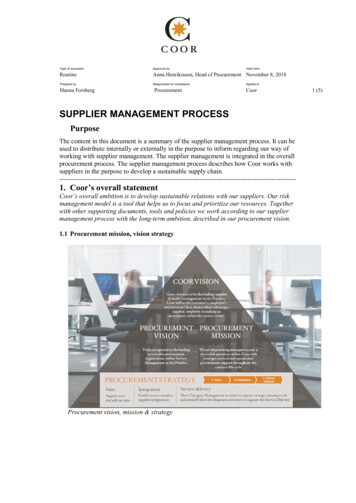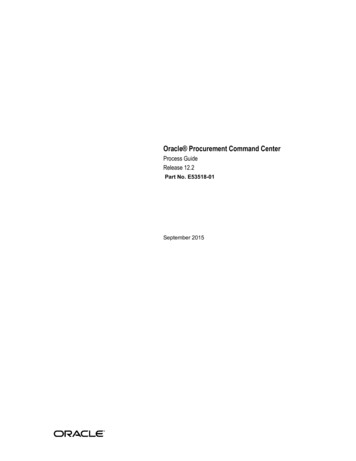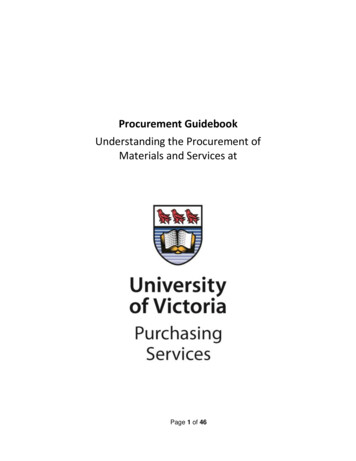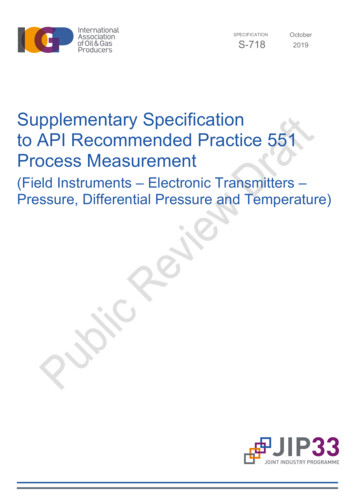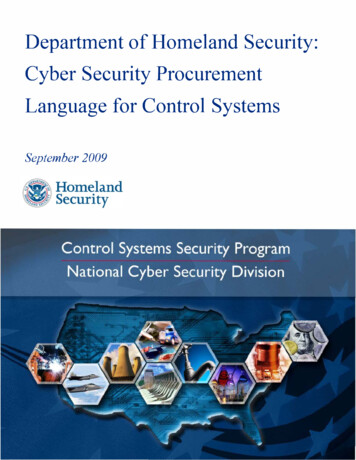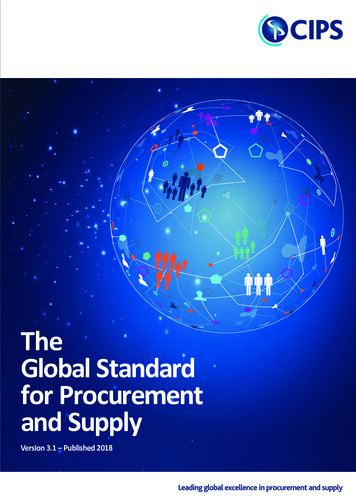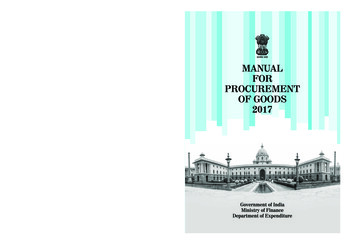
Transcription
ManualforProcurementof Goods2017Government of IndiaMinistry of FinanceDepartment of Expenditure
Foreword1.Government organizations procure a wide variety of goods and services and undertakeexecution of works in pursuance of their duties and responsibilities. With a view toimproving transparency in decision making in public procurement and reducing thescope for subjectivity, Department of Expenditure in 2006 had prepared a set of threeManuals on Policies and Procedures for Procurement of Goods, Works and hiring ofConsultants, in conformity with the General Financial Rules (GFR), 2005. Over the years,these Manuals have served as a guide book for procurement.2.In the last few years, the Government of India has issued new instructions in the domainof public procurement. Some of these important changes include introduction of CentralPublic Procurement Portal (CPPP), Government e-Marketplace (GeM), preferential marketaccess for micro and small enterprises, preference for domestic manufacturers of electronicgoods, inclusion of integrity pact, etc. The GFR has been revised comprehensively inMarch 2017 covering inter-alia these set of new instructions. Consequently the Manualof Procurement too has been revised after a decade and within a month of the releaseof GFR 2017.3.The new Manual on Procurement of Goods has been extensively revised in keeping withGFR 2017 and in consonance with the fundamental principles of transparency, fairness,competition, economy, efficiency and accountability. Efforts have been made to coverall major aspects of procurement in this Manual in a user-friendly manner. The manual isthe outcome of extensive consultations in two stages with Ministries/Departments/PSUsand other organizations over a period of six months.4.Manuals issued by this Department are to be taken as generic guidelines, which haveto be necessarily broad in nature. Ministries/Departments are advised to supplementthis manual to suit their local/specialized needs, by issuing their own detailedmanuals (including customized formats); Standard Bidding Documents and Schedule ofProcurement Powers to serve as detailed instructions for their own procuring officers.5.I would like to acknowledge the lead taken by Dr. Vivek Joshi, Joint Secretary, DoE anddedicated efforts of Shri Sanjay Aggarwal, Director (PPD), Shri Vinayak T. Likhar, UnderSecretary(PPD) and Shri Girish Bhatnagar, Consultant (Public Procurement) in revision ofthis Manual. I would also like to thank Ministries, Departments, other organisations andindividuals who reviewed the drafts of the Manual and provided their valuable inputs.6.I hope that this Manual would be useful to procuring officials working in various Ministries/Departments as operating instructions and will bring about greater transparency andpredictability in government procedures and help in improving the ease of doing Businesswith Government.Date : 05.04.2017(Ashok Lavasa)Finance Secretary
Manual for Procurement of Goods 2017Ministry of FinanceDepartment of ExpenditureDisclaimerWhile every care has been taken to ensure that the contents of this manual are accurateand up to date till March 2017, the procuring entities are advised to check the precisecurrent provisions of law and other applicable instructions from the original sources. Incase of any conflict between the provisions stipulated in this manual and in the originalsource such as GFR or the prevailing laws, the provisions contained in the extant law andthe original instructions shall prevail.v
Table ofContentsManual for Procurement of Goods 2017Ministry of FinanceDepartment of ExpenditureTable of ContentsForewordiiiDisclaimervTable of ContentsviiAbbreviations and AcronymsxiiiProcurement GlossaryxviiChapter 1: Introduction – Policies and Principles1.1Procurement Rules and Regulations; and this Manual11.2Clarification, Amendments and Revision of this Manual11.3Applicability of this Manual21.4Authorities competent to purchase goods and their Purchase Powers31.5Basic Aims of Procurement – the Five R’s of Procurement31.6Refined Concept of Cost & Value – Value for Money41.7Fundamental Principles of Public Procurement41.8Standards (Canons) of Financial Propriety81.9Public Procurement Infrastructure at the Centre81.10 Product Reservation and Preferential/Mandatory Purchase from certain sources91.11 Proactive Information Disclosures141.12 Public Procurement Cycle15Chapter 2: Need assessment, formulation of Specifications andProcurement Planning2.1Need Assessment162.2Formulation of Technical specifications (TS)192.3Obtaining Technical, Administrative and Budgetary Sanctions/Approvals and signing of Indents222.4Procurement Planning23Chapter 3: Supplier Relationship Management3.1Supplier Relationship Management253.2Code of Integrity for Public Procurement (CIPP)25vii
Manual for Procurement of Goods 2017Ministry of FinanceDepartment of ExpenditureTable ofContents3.3Integrity Pact (IP)283.4Development of New Sources and Registration of Suppliers303.5Grades of Debarment of Suppliers343.6Compulsory Enlistment of Indian Agents38Chapter 4: Modes of Procurement and Bidding Systems4.1Modes of Procurement394.2Open Tender Enquiry (OTE)404.3Global Tender Enquiry (GTE)414.4Limited Tender Enquiry (LTE)434.5Special Limited Tender Enquiry for Procurements More thanRs. 25 (Rupees twenty-five) Lakh444.6Proprietary Article Certificate454.7Single Tender Enquiry (STE) without a PAC464.8Drawals against Rate Contract (RC)/Framework Contract (FC)474.9Direct Procurement without Quotation504.10 Direct Procurement by Purchase Committee514.11 Purchase through Central Purchase Organisation or other Organizations524.12 Bidding Systems534.13 Single Stage Bidding System534.14 Two Stage Bidding - Expression of Interest Tenders – Market Exploration574.15 Electronic Procurement (e-Procurement)594.16 Electronic Reverse Auction (RA)604.17 One Stop Government e-Marketplace (GeM) by DGS&D61Chapter 5: Preparing bid documents, publication, receipt andopening of bids5.1Preparation of Bid Documents645.2Receipt and Custody of Tenders715.3Procedures to be followed during Bid Opening74viii
Table ofContentsManual for Procurement of Goods 2017Ministry of FinanceDepartment of ExpenditureChapter 6: Forms of Securities, Payment Terms and Price Variations6.1Forms of Security776.2Payment Clause796.3Terms of Payment for Domestic Goods816.4Terms of Payment for Imported Goods826.5Advance Payment846.6Firm Price vis-à-vis Variable Price856.7Exchange Rate Variation876.8Taxes, Duties and Levies886.9Incoterms Terms of Delivery906.10 e-Payment916.11 Deduction of Income Tax, Service Tax, and so on, at Source fromPayments to Suppliers916.12 Recovery of Public Money from Supplier’s Bill916.13 Refund from Supplier916.14 Payment against Time Barred Claims92Chapter 7: Evaluation of Bids and Award of Contract7.1Tender Evaluation937.2Preparation and Vetting of Comparative Statement947.3Preliminary Examination947.4Evaluation of Responsive Bids and Decision on Award of Contract967.5Deliberations by the Tender Committee for Award of Contract1007.6Award of Contract107Chapter 8: Rate Contract and other Procurements withspecial features8.1Rate Contracts1138.2Handling Procurement in urgencies/Emergencies and Disaster Management1198.3Buy Back Offer119ix
Manual for Procurement of Goods 2017Ministry of FinanceDepartment of ExpenditureTable ofContents8.4Capital Goods/Equipment (Machinery and Plant – M&P)1208.5Turnkey Contract1218.6Annual Maintenance Contract (AMC)121Chapter 9: Contract Management9.1Contract Management1249.2Amendment to the Contract1249.3Operation of Option Clause1259.4Safeguards for Handing over Procuring Entity Materials/Equipment to Contractors 1269.5Payments to the Contractor and Handling of Securities1279.6Monitoring of Supplier Performance1279.7Delays in Performance of Contract1279.8Breach of Contract, Remedies and Termination1339.9Dispute Resolution1349.10 Closure of Contract1359.11 Goods Receiving1369.12 Quality Assurance and Inspection1379.13 Storage and Issue of Inspected Goods1449.14 Accounting and Payment of Received Materials144Chapter 10: Disposal of Scrap Goods10.1 Scrap for Disposal14710.2 Classification and Categorisation14710.3 Survey of Materials for Classifying as Scrap for Disposal14710.4 Modes of Disposal14810.5 Preparation for Disposal14910.6 Conditions of Disposal Applicable to all Modes of Disposal15010.7 Disposal through Tender15010.8 Disposal through Auction15210.9 Disposal at scrap value or by other modes15310.10 Delivery of Sold Material15310.11 Procedure for Adjustment of Sale Proceeds in the Books of Accounts156x
AnnexureManual for Procurement of Goods 2017Ministry of FinanceDepartment of ExpenditureAnnexureAnnexure1:Procurement Guidelines159Annexure2A:Delegation of Financial Powers – Indents, Contracts andPurchases for public service160Annexure2B:Powers for Incurring Contingent Expenditure161Annexure2C:Suggested Structure of Schedule of Procurement Powers (SoPP)162Annexure3:Purchase Requisition (Indent) for Goods (Non-stock)165Annexure4A:Purchase Requisition Register for Indenters166Annexure4B:Purchase Requisition Register for Procuring Entity167Annexure5:Limited Tender Form168Annexure6:Proprietary Article Certificate171Annexure7:Purchase without Quotation Format172Annexure8:Purchase Committee Certificate Format173Annexure9:Sample Prequalification Criteria174Annexure10:Bid Opening Attendance Sheet cum Report177Annexure11:Tender Committee Minutes Format178Annexure12:Invitation and Declaration for Negotiations180Annexure13:Format of Revised Offer in Negotiations181Annexure14:Letter (Notification) of Award (LoA) of Contract182Annexure15:Example of Formula for Price Variation s of Supply Order Register186Annexure18:Proposal for Extension of Delivery Period187Annexure19:Format for Extension of Delivery Period/Performance Notice189Annexure20:Model Format for Correspondence with Supplier afterExpiry of Delivery Date191Annexure21:No Claim Certificate192Annexure22:Goods Receipt and Inspection Report193Annexure23:Pay Order Form194Annexure24:Survey Committee’s Report195Annexure25:Sale Account for Goods Disposed196Annexure26:List of Handloom Items Notified for Purchase from KVIC/ACASH197Annexure27:List of Medicines Reserved for procurement from Pharma CPSEs200Annexure28:Domestically Manufactured Electronic Products (DMEP)204xi
Manual for Procurement of Goods 2017Ministry of FinanceDepartment of ExpenditureAppendixAppendixAppendix 1:Advanced Concepts of Value for Money1.0The Concept of Value2072.0Total Cost of Ownership2073.0Value for Money208Appendix 2:Legal Aspects of Public Procurement1.0Relevant Provisions of the Constitution of India2092.0Salient Features of the Indian Contract Act2103.0Salient Features of the Sales of Goods Act, 19302164.0Salient Features of the Indian Arbitration & ConciliationAct 19962185.0Salient Features of Competition Act, 2002 relating toAnti-competitive Practices2236.0Salient Features of the Whistle Blowers Protection Act,2011 and the Whistle Blowers Protection (Amendment)Act, 2015226Appendix 3:Electronic Procurement (e-Procurement) and e-Auction1.0Electronic procurement (e-Procurement)2292.0Service Provider2293.0Process2294.0Disposal through e-Auction231Appendix 4:Management of Public Procurement Function1.0Organisation of Procurement Function2362.0Management Reporting2363.0Record Keeping237Appendix 5:Templates for Management Reports and KPIsxii238
Abbreviationsand AcronymsManual for Procurement of Goods 2017Ministry of FinanceDepartment of ExpenditureAbbreviations and AcronymsACASHAssociation of Corporations and Apex Societies of HandloomsAITBAdditional Instructions to Bidders (may in some instances be called Bid DataSheet – BDS or Tender Information Sheet -TIS)AMCAnnual Maintenance ContractBCBill Currency (selling/buying)BEEBureau of Energy EfficiencyBGBank GuaranteeBISBureau of Indian StandardsBOCBid Opening CommitteeBSTCBuyer Specific Terms & ConditionsBSVBalance Sale ValueC&AGComptroller and Auditor General (of India)CACompetent AuthorityCAPEXCapital Expenditure (model of acquisition/procurement)CBICentral Bureau of InvestigationCCICompetition Commission of IndiaCFRCost and FreightCHACustom House AgentCIFCost Insurance and FreightCIPCarriage and Insurance PaidCIPPCode of Integrity for Public ProcurementCOMPATCompetition Appellate TribunalCOTSCommercially Off The Shelf (Items)CPCBCentral Pollution Control BoardCPOCentral Purchasing OrganizationsCPPPCentral Public Procurement PortalCPSECentral Public Sector EnterpriseCSTCentral Sales TaxCVCCentral Vigilance CommissionCVOChief Vigilance OfficerDCFDiscounted Cash FlowDDODirect Demanding Officer (for RCs)DFPRDelegation of Financial Powerxiii
Manual for Procurement of Goods 2017Ministry of FinanceDepartment of ExpenditureDGS&DDirectorate General of Supplies and DisposalsDMEPDomestically Manufactured Electronic ProductsDSCDigital Signature CertificateeASPE-Auction Service ProviderECSElectronic Clearing SystemEFTElectronic Funds TransferEMDEarnest Money DepositEoIExpression of Interest (Tender)EPMExport Promotion and MarketingERVExchange Rate VariationEXIMExport Import (Policy)FA (&CAO)Financial Adviser (and Chief Accounts Officer)FASFree Alongside ShipFCFramework ContractFEMAForeign Exchange Management ActFMForce MajeureFOBFree On BoardFORFree On RailFOTFree On TruckGCCGeneral Conditions of ContractGCSGeneral Conditions of SaleGeMGovernment Electronic MarketGFRGeneral and Financial Rules, 2017GoIGovernment of IndiaGRIRGoods Receipt and Inspection ReportGTCGeneral Terms & ConditionsGTEGlobal Tender EnquiryHODHead of the DepartmentIEMIndependent External MonitorINCOTERMS International Commercial TermsIPIntegrity PactIRDAInsurance Regulatory and Development AuthorityISIIndian Standards InstituteISOInternational Organization for StandardizationxivAbbreviationsand Acronyms
Abbreviationsand AcronymsManual for Procurement of Goods 2017Ministry of FinanceDepartment of ExpenditureITBInstructions to Bidders (may in some instance be called Instructions to Tenderers ITT)ITJIndian Trade JournalKPIsKey Performance IndicesKVICKhadi and Village Industries CommissionL1Lowest BidderLCLetter of CreditLCCLife Cycle CostingLDLiquidated DamagesLoALetter (Notification) of Award also called Acceptance of Tender (A/T)LPPLast Purchase PriceLTELimited Tender EnquiryM&PMachinery and PlantMeitYMinistry of Electronics and Information TechnologyMoEFMinistry of Environment and ForestsMRPMaximum Retail PriceMSEMicro and Small EnterpriseMSME(D)Micro Small and Medium Enterprises (Development Act, 2006)MSTCMetal Scrap Trading CorporationNEFTNational Electronic Funds TransferNICNational Informatics CentreNITNotice Inviting TenderNSICNational Small Industries CorporationNTHNational Test HouseOEMOriginal Equipment ManufacturerOPEXOperating Expense (model of acquisition/procurement)OTEOpen Tender EnquiryPACProprietary Article CertificatePBGPerformance Bank Guarantee, also see SDPPDProcurement Policy Division, Department of Expenditure, Ministry of FinancePPPPublic Private PartnershipPQBPre-qualification BiddingPQCPre-qualification CriterionPRPurchase Requisition/Indentxv
Manual for Procurement of Goods 2017Ministry of FinanceDepartment of ExpenditureAbbreviationsand AcronymsPSUPublic Sector UndertakingPVCPrice Variation ClauseQAQuality AssuranceRA/eRAElectronic Reverse AuctionRBIReserve Bank of IndiaRCRate Contract (or Framework Contract FC)(S)RfP(Standard) Request for Proposals (Document)RTGSReal Time Gross SettlementRTIRight to InformationSBDStandard Bidding DocumentSCSurvey CommitteeSCCSpecial Conditions of ContractSDSecurity Deposit, also see PBGSLAService Level AgreementSLTESpecial Limited Tender (Enquiry)SoPPSchedule of Procurement PowersSPCBState Pollution Control BoardSTASubject to AcceptanceSTCSpecial Terms &ConditionsSTESingle Tender EnquiryTCTender Committee also called Tender Purchase or Evaluation Committee (TPC/TEC)TCOTotal Cost of OwnershipTCSTax Collected at SourceTDSTax Deducted at SourceToRTerms of ReferenceTSTechnical SpecificationUCP 600The Uniform Customs and Practice for Documentary Credits (UCPDC or simplyUCP)UNCITRALUnited Nations Commission on International Trade LawURDG 758Uniform Rules for Demand GuaranteesVATValue Added TaxVfM(Best) Value for MoneyWOLWhole of Life (Cost) or Total Cost of Ownership TCOxvi
ProcurementGlossaryManual for Procurement of Goods 2017Ministry of FinanceDepartment of ExpenditureProcurement GlossaryIn this Manual and in the ‘Procurement Guidelines’, unless the context otherwise requires1:i)“Bid” (including the term ‘tender’, ‘offer’, ‘quotation’ or ‘proposal’ in certain contexts)means an offer to supply goods, services or execution of works made in accordancewith the terms and conditions set out in a document inviting such offers;ii)“Bidder” (including the term ‘tenderer’, ‘consultant’ or ‘service provider’ in certaincontexts) means any eligible person or firm or company, including a consortium (that isan association of several persons, or firms or companies), participating in a procurementprocess with a Procuring Entity;iii)“(Standard) Bid(ding) documents” (including the term ‘tender (enquiry) documents’ or‘Request for Proposal Documents’ – RfP documents in certain contexts) means a documentissued by the Procuring Entity, including any amendment thereto, that sets out the termsand conditions of the given procurement and includes the invitation to bid. A Standard(Model) Bidding Document is the standardised template to be used for preparing BiddingDocuments after making suitable changes for specific procurement;iv)“Bidder registration document” means a document issued by a Procuring Entity, includingany amendment thereto, that sets out the terms and conditions of registration proceedingsand includes the invitation to register;v)“Bid security” (including the term ‘Earnest Money Deposit’(EMD), in certain contexts)means a security from a bidder securing obligations resulting from a prospective contractaward with the intention to avoid: the withdrawal or modification of an offer withinthe validity of the bid, after the deadline for submission of such documents; failure tosign the contract or failure to provide the required security for the performance of thecontract after an offer has been accepted; or failure to comply with any other conditionprecedent to signing the contract specified in the solicitation documents.;vi)“Central Public sector enterprise” means a body incorporated under the Companies Actor established under any other Act and in which the Central Government or a Centralenterprise owns more than 50 per cent of the issued share capital;vii)“Central Purchase Organisation” means a Procuring Entity which is authorised by theGovernment of India by an order, made in this behalf, to make procurement for oneor more procuring entities or to enter into rate contracts or framework agreements forprocurement by other procuring entities. At present, the Director General of Supplyand Disposals (DGS&D) is such an authority. However Government can authorise otherOrganisations for specific categories of materials;viii)“Competent authority” means the officer(s) who finally approves the decision.The main preferred term is within the inverted commas. Alternative equivalent terms used in certain contexts, if any,are listed in the brackets. Text within brackets is not considered for sort-order of terms.1xvii
Manual for Procurement of Goods 2017Ministry of FinanceDepartment of ExpenditureProcurementGlossaryix)“Consultancy services” means a one-off (that is, not repetitive and not routine) services,involving project specific intellectual and procedural processes using establishedtechnologies and methodologies but the outcomes – which are primarily of non-physicalnature – may not be standardised and would vary from one consultant to another. It mayinclude small works or supply of goods which are incidental or consequential to suchservices;x)“e-Procurement” means the use of information and communication technology (speciallythe internet) by the Procuring Entity in conducting its procurement processes with biddersfor the acquisition of goods (supplies), works and services with the aim of open, nondiscriminatory and efficient procurement through transparent procedures;xi)“Goods” includes all articles, material, commodity, livestock, medicines, furniture,fixtures, raw material, consumables, spare parts, instruments, machinery, equipment,industrial plant, vehicles, aircrafts, ships, railway rolling stock assemblies, sub-assemblies,accessories, a group of machines comprising an integrated production process or suchother categories of goods or intangible, products like technology transfer, licenses,patents or other intellectual properties (but excludes books, publications, periodicals,etc., for a library), procured or otherwise acquired by a Procuring Entity. Procurementof goods may include certain small work or some services, which are incidental orconsequential to the supply of such goods, such as transportation, insurance, installation,commissioning, training and maintenance;xii)“Indenter” ( or the term ‘User (Department)’ in certain contexts) means the entity andits officials initiating a procurement indent, that is, a request to the Procuring Entity toprocure goods, works or services specified therein;xiii)“Inventory” means any material, component or product that is held for use at a latertime;xiv)“Invitation to (pre-)qualify” means a document including any amendment theretopublished by the Procuring Entity inviting offers for pre-qualification from prospectivebidders;xv)“Invitation to register” means a document including any amendment thereto publishedby the Procuring Entity inviting offers for bidder registration from prospective bidders;xvi)“Non-consultancy services” includes services of physical and procedural nature andare bid and contracted on the basis of performance of a measurable physical output,and for which performance standards can be clearly identified and consistently appliedsuch as drilling, aerial photography, satellite imagery, mapping and similar operations.It may include small works or supply of goods which are incidental or consequential tosuch services;xvii)“ Notice inviting tenders” (including the term ‘Invitation to bid’ or ‘request for proposals’in certain contexts) means a document and any amendment thereto published or notifiedby the Procuring Entity, which informs the potential bidders that it intends to procuregoods, services and/or works.;xviii
ProcurementGlossaryManual for Procurement of Goods 2017Ministry of FinanceDepartment of Expenditurexviii)“Pre-qualification (bidding) procedure” means the procedure set out to identify, prior toinviting bids, the bidders that are qualified to participate in the procurement;xix)“Pre-qualification document” means the document including any amendment theretoissued by a Procuring Entity, which sets out the terms and conditions of the prequalification bidding and includes the invitation to pre-qualify;xx)“Procurement” or “public procurement” (or ‘Purchase’, or ‘Government Procurement/Purchase’ in certain contacts) means acquisition by way of purchase, lease, license orotherwise, either using public funds or any other source of funds (e.g. grant, loans, gifts,private investment etc.) of goods, works or services or any combination thereof, includingaward of Public Private Partnership projects, by a Procuring Entity, whether directly orthrough an agency with which a contract for procurement services is entered into, butdoes not include any acquisition of goods, works or services without consideration, andthe term “procure” or “procured” shall be construed accordingly;xxi)“Procurement contract” (including the terms ‘Purchase Order’ or ‘Supply Order’ or‘Withdrawal Order’ or ‘Work Order’ or ‘Consultancy Contract’ or ‘Contract for Services’under certain contexts), means a formal legal agreement in writing relating to the subjectmatter of procurement, entered into between the Procuring Entity and the supplier, serviceprovider or contractor on mutually acceptable terms and conditions and which are incompliance with all the relevant provisions of the laws of the country. The term “contract”will also include “rate contract’ and “framework contract”;xxii)‘(Public) Procurement Guidelines” means guidelines applicable to Public Procurement,consisting of under relevant context a set of – i) Statutory Provisions (The Constitution ofIndia; Indian Contract Act, 1872; Sales of Goods Act, 1930; and other laws as relevantto the context); ii) Rules & Regulations (General Financial Rules, 2017; Delegation ofFinancial Power Rules and any other regulation so declared by the Government); iii)Manuals of Policies and Procedures for Procurement (of Goods; Works; ConsultancyServices or any for other category) promulgated by the Ministry of Finance and iv)Procuring Entity’s Documents relevant to the context (Codes, Manuals and Standard/Model Bidding Documents);xxiii)“Procurement process” means the process of procurement extending from the assessmentof need; issue of invitation to pre-qualify or to register or to bid, as the case may be; theaward of the procurement contract; execution of contract till closure of the contract;xxiv)“Procuring authority” means the officer who finally approves as well as those officialsand committee members who submit the notes/reports for the approval for any decision.xxv)“Procuring Entity” means any Ministry or Department of the Central Government or aunit thereof or its attached or subordinate office to which powers of procurement havebeen delegated;xxvi)“Prospective bidder” means anyone likely or desirous to be a bidder;xxvii) “Public Private Partnership” means an arrangement between the central, a statutory entityor any other Government-owned entity, on one side, and a private sector entity, on thexix
Manual for Procurement of Goods 2017Ministry of FinanceDepartment of ExpenditureProcurementGlossaryother, for the provision of public assets or public services or both, or a combination thereof,through investments being made or management being undertaken by the private sectorentity, for a specified period of time, where there is predefined allocation of risk betweenthe private sector and the public entity and the private entity receives performancelinked payments that conform (or are benchmarked) to specified and predeterminedperformance standards, deliverables or Service Level agreements measurable by thepublic entity or its representative;xxviii) “Rate contract” ( or the term ‘framework agreement’ in certain contexts) means anagreement between a Central Purchase Organisation or Procuring Entity with one ormore bidders, valid for a specified period of time, which sets out terms and conditionsunder which specific procurements can be made during the term of the agreementand may include an agreement on prices which may be either predetermined or bedetermined at the stage of actual procurement through competition or a predefinedprocess allowing their revision without further competition;xxix)“Registering authority” means an authority which registers bidders for different categoriesof procurement.xxx)“Registered Supplier” means any supplier who is on a list of registered suppliers of theProcuring Entity or a Central Purchase Organisation;xxxi)“Reverse auction” (or the term ‘Electronic reverse auction’ in certain contexts) meansan online real-time purchasing technique utilised by the Procuring Entity to select thesuccessful bid, which involves presentation by bidders of successively more favourablebids during a scheduled period of time and automatic evaluation of bids;xxxii) “Service” means any subject matter of procurement other than goods or works, exceptthose incidental or consequential to the service, and includes physical, maintenance,professional, intellectual, training, consultancy and advisory services or any other serviceclassified or declared as such by a Procuring Entity but does not include appointment ofan individual made under any law, rules, regulations or order issued in this behalf;xxxiii) “Subject matter of procurement” means any item of procurement whether in the form ofgoods, services or works or a combination thereof;xxxiv) “Works” refer to any activity, sufficient in itself to fulfil an economic or technical function,involving construction, fabrication, repair, overhaul, renovation, decoration, installation,erection, excavation, dredging, and so on, which make use of a combination of oneor more of engineering design, architectural design, material and technology, labour,machinery and equipment. Supply of some materials or certain services may be incidentalor consequential to and part of such works. The term “Works” includes (i) civil works forthe purposes of roads, railway, airports, shipping-ports, bridges, buildings, irrigationsystems, water supply, sewerage facilities, dams, tunnels and earthworks; and so on,and (ii) mechanical and electrical works involving fabrication, installation, erection,repair and maintenance of a mechanical or electrical nature relating to machinery andplants.xx
Chapter – 1Manual for Procurement of Goods 2017Ministry of FinanceDepartment of ExpenditureIntroduction – Policies and Principles1.1Procurement Rules and Regulations and this ManualVarious Ministries, Departments, attached and subordinate offices, local urban bodies, publicsector enterprises and other Government (including autonomous)bodies (hereinafter referred as‘Procuring Entities’) spend a sizeable amount of their budget on procurement of goods, worksand services to discharge the duties and responsibilities assigned to them.The Ministries/Departments have been delegated powers to make their own arrangementsfor procurement of goods under the Delegation of Financial Power Rules, which have to beexercised in conformity with the ‘Procure
these Manuals have served as a guide book for procurement. 2. In the last few years, the Government of India has issued new instructions in the domain of public procurement. Some of these important changes include introduction of Central Public Procurement Portal (CPPP), Government e-Marketplace (GeM), preferential market





